| |
Bill Luke has been a devotee of buses and bus travel from a very early age. He was born in Duluth, Minnesota, an area noted for a number of early major bus lines like Greyhound and National City Lines. As a kid, Luke became fascinated with the history and activities of these major lines—and his interest soon spread to others. Soon Luke was collecting bus memorabilia, and then began a career in the bus industry. Luke worked for the Jefferson Transportation Company of Minneapolis, and later, for the Empire Lines in Spokane. Until 1996, Luke also published a well known bus and motor coach trade publication, Bus Ride, which covered the people, products and services in this ever-evolving industry.
Luke's collection is filled with photographs, periodicals, and hard to find ephemeral material such as uniform patches, tickets, company publications, timetables, and route maps for bus lines operating throughout the United States. The images below provide a few examples from this collection:
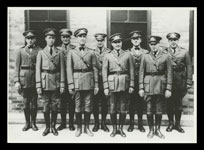 |
Greyhound bus drivers pose in their new uniforms in the late 1920s. These uniform jackets, pants, caps and boots gave drivers a very professional appearance--implying that Greyhound bus riders would enjoy a safe and comfortable trip with these experts at the wheel. THF.108451 Gift of William Luke. |
| |
|
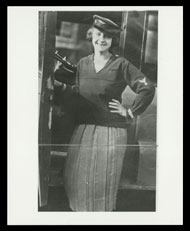 |
Not all bus pioneers were men. Helen Schulz started the Red Ball Transportation Company in 1922. The route ran from Waterloo to Des Moines, Iowa. Schulz successfully faced challenges like competition from rival bus lines and the railroad, government regulations, and poor highways. Schulz sold Red Ball to Jefferson Highway and Transportation Company in 1930. THF.108453 Gift of William Luke. |
| |
|
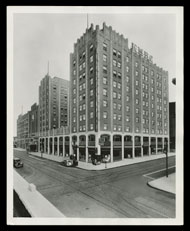 |
Bus terminals of the 1920s and 1930s were often located in hotels. This is the Pickwick Hotel in Kansas City. The Pickwick organization owned the Pickwick bus line, and often built terminals inside or adjacent to their hotels. The bus terminal located on the first floor of this hotel featured a turntable that rotated buses 180 degrees within a narrow space—allowing buses to exit the same way they entered. THF.108455 Gift of William Luke. |
| |
|
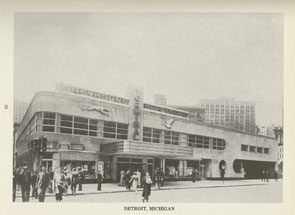 |
 |
| Bus terminals were often attractive as well as practical. Many terminals of the 1930s and 1940s sported streamlined facades—the height of modernity during this time. The streamlined exterior of the Detroit terminal and its first floor layout are shown in these images. This busy terminal handled bus traffic from two former rival bus lines—Greyhound and Blue Goose—by this time both owned by Greyhound. These illustrations appeared in a 1941 book, “Modern Bus Terminals and Post Houses,” that featured photographs and floor plans of 45 recently-built bus terminals from around the country. THF.108459 and THF.108460 Gift of William Luke. |
|
| |
|
|
Bus Transportation magazine sponsored a yearly contest for the best window displays promoting the industry. This piece was one winner in 1940. The judging staff called it “a highly original design with ‘stop and look’ appeal.” This effective piece of bus terminal window dressing enticed viewers to dream of a Michigan vacation enjoyed while traveling on the Blue Goose line. THF.108462
Gift of William Luke. |
| |
|
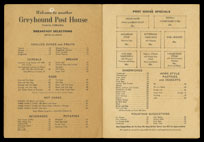 |
Many long distance bus companies operated special restaurants to service their travelers. This 1955 menu from the Greyhound line explains that Greyhound’s post houses were established to guarantee quality food and sanitary conditions for their travelers. In the days of stagecoach travel, post houses were stops along the way where travelers could rest, eat, and possibly even secure lodgings. THF.108464 Gift of William Luke. |
| |
|
 |
These attractive patches, worn on drivers’ uniforms, offer a small indication of the numerous bus lines that have operated in the United States over the past 100 years. THF.108466 Gift of William Luke. |
| |
|
 |
In this 1980 photograph, rapid transit buses move down the assembly line at the General Motors Truck & Bus Division in Pontiac, Michigan. These buses were part of an order for 940 vehicles bound for the Southern California Rapid Transit District in Los Angeles. THF.108469 Gift of William Luke. |
| |
|
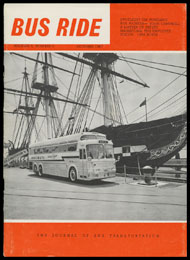 |
Bus Ride magazine kept its readers apprised of the latest developments in the bus industry, including new technologies, changing regulations, and the evolving travel market. The Luke collection includes a complete run of Bus Ride magazine from 1967 to 2012, providing a glimpse of opportunities and challenges faced by the bus industry over the decades of the 20th century and into the 21st. This trade publication also offers a rich array of historical information about individual bus lines. THF.108470 Gift of William Luke. |
| |
-- Terry Hoover, Chief Archivist |
|

